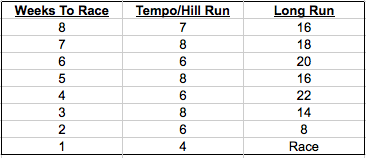Ramping Up for Marathon Take-Off: How To Condense Your Training Plan & Still Get Ready
Whether you are coming back from injury or just realized you only have a few weeks left to race day, your problem is the same question I receive almost daily via email: How can I modify my training plan to get ready for my next marathon in a short time frame?
I get this question because Marathon Nation is known for choosing quality training over quantity; we train this way because it yields maximum results in minimum time. But let’s be clear that there are no shortcuts. The plans aren’t easy. At the end of the day you still need to be able to run 26.2 miles well, regardless of what training program you follow.
If your training window is small, know that picking up the traditional plan won’t do much good, as the mileage mere weeks before race day is pretty darn beefy. Often to the tune of 18, 20, or even 22 miles. There’s just no way you can leap into that type of a run (or training week) without the proper preparation. You are risking your health and potentially creating some serious fatigue that will linger until the big day.
Here’s the official Marathon Nation guidance on how to add miles to a marathon training program within a compressed time frame.
Step One: Identify the Key Runs
Between now and your marathon, you have a ton of runs on your schedule. Right away the long runs are “key,” so circle all of them. Then pick one more set of runs: if the race is hilly then hill work is important. If the race is flat then tempo runs (not track work) is important. Do the math back from race day to identify just how many of these runs you will be able to get (assuming one each per week).
Step Two: Build A Basic Week
Let’s assume you have 8 weeks until race day, leaving you with 8 weeks of runs. Technically not an equal 8 weeks, however, as you’ll need to taper down the long run pre-race…so know that the early runs are more important to get done than the later ones (you are motivated, right!?).
Map out your 8 Weeks into a simple sheet. As in the example below. This will really give you a sense of just what you’ll need to do to be ready, at a minimum, to complete your race.
Then build an actual weekly table that fits into your current life / training cycle. Again, I have provided an example here for you to work off of.
Note that the tempo or hill run is on Tuesday, after a day of cross training and before a day off. This means it will be a run you can hit on all cylinders. Then the long run run is on Saturday, also preceded by cross training and followed by a day off. The new run on the schedule, Thursday, is essentially 50% of your long run volume for that weekend.
Tempo/Hill Run: Done as listed on your schedule. Should be manageable as it’s short.
50% Run: Done at or as close to your goal marathon pace as you can sustain for the full run. It’s tempting to pretend like you lost zero fitness, but the reality is that your body will need time to get back to where it once was. These runs will give you a good indication of just how far you are from the fitness you’d like to attain.
Long Run: Should be done as first half easy / long run pace, then second half closer to goal race pace. Ideally this will be a negative split run, where you get faster over the course of the day. Don’t force it; you’ll be carrying some fatigue from Thursday and might do well enough to just get the full distance in.
That’s it — three main runs for your week. We don’t want to force more on the schedule in terms of bigger runs as you are on the comeback trail. Also, it’s likely your mental / social bandwidth will need some adjustment to full on training again, and this approach affords you that luxury.
What is Cross-Training? It can be anything outside of running. Cycling is a great alternative, as is swimming or almost any aerobic machine at the gym. Regardless of which modality you choose, keep the effort moderate enough so that it doesn’t impact your key runs. Try also to leave some time so you can get in a little light stretching at the end of your session.
Where Could More Running Go? If you are feeling up to it, you can put some light running on the days listed as cross training. Think zone 2, steady effort with some sharpening work at the end, such as a skill run [link]. But no need to do longer, or harder runs than you have already listed in your week.
Step Three: Commit & Recover
Once you have built out your plan, you have to stick with it. Many people on the comeback trail aren’t 100% committed in that a marathon sounds like a cool thing to do but they continue to struggle to get the workouts done. In a shortened program, there is little to no room for error, so be sure that in means IN…otherwise opt out and refocus on a later event.
Outside of the training work to be done, you’ll also need to be 100% on top of your recovery game so that you can reduce fatigue and ease your body back into the full routine of running. In addition to post run care like icing, ice baths, self-massage, etc., you can also work to factor in a 15- to 20-minute session of stretching each day.
What if the runs prove to be too hard? Learning to adjust and adapt is a critical determinant if your marathon bid is to be successful. Here are some options:
Plan A: Try to Run as Planned. If it ain’t broke, don’t fix it. Get the runs done and note where things are challenging. These could be future points of friction that you could ward off with focused self-care or additional recovery.
Plan B: Just run for the allotted time. If your magical paces are eluding you, don’t force it. Instead drop back to run at a sustainable pace that allows you to get the full distance in. At this point in the game, the distance is more important than the speed. Instead of forcing it, let the speed come to you as you continue to exercise.
Plan C: Split the Run. Assuming the epic mileage of some (or all) of these long runs is a bit too much, you can divide them up to make them more manageable. I have provided an example below where the Saturday long run is split to Sat/Sun, with the Saturday effort being an easier/steadier run, and Sunday is closer to your marathon goal pace with perhaps some tempo work included. Note that the long run of 18 is a bit of a leap, but by that time in the program you should be ready to handle that volume.
Step Four: Build A Solid Race Plan
Racing is much more than just fitness; you need an actual plan you can execute on the big day. This plan needs to take into account your training, your current fitness, and most importantly — your new race day goals. Few things are worse than over-achieving for the first 13 miles on race day only to suffer through the remainder. Instead of going into too much detail, I suggest you download our marathon pace planner here. [LINK]
Conclusion
Before I let you go, I need to confess that I believe in endurance fate. If something is threatening your big race experience, chances are that might not be a bad thing. Before you throw caution and commonsense aside, think long and hard about your plan. After all, there will be another marathon next weekend…and the one after that. Better that you are ready to race at 100% than post a sub-optimal result that could set you physically and mentally back.
So if you feel pain or discomfort, or are simply unable to meet the training paces or even have a general lack of motivation to run…please reconsider the effort. At the end of the day this is all just a game and is meant to be fun. If it ain’t fun, why do it?
Best of luck with your training and if you have any questions please post them to our Facebook or Twitter pages!





5 Responses to “Ramping Up for Marathon Take-Off: How To Condense Your Training Plan & Still Get Ready”